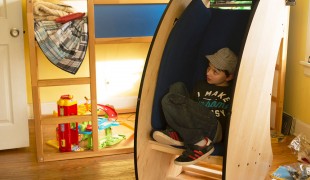- 6114
- 434
- 6
- 9
- 0
- Help Ukraine
About the solution
Matthew’s school desk was a hurdle in his learning. The specialist team that deals with the boy’s angry behaviours were not able to get him to do things and learn, as he was always distracted. Matthew’s family was not able to find a desk on the market that would meet his needs, and they couldn’t design a desk themselves.
That’s when they met Bob Woolf, Eileen Bloustien and Janet Garner, from the charity May We Help (an organisation that develops gadgets to increase the autonomy level of disabled people).
This team created a custom focus desk, which design specifically addresses sensory issues with positioning, enclosure, colours, and lighting to provide a more productive learning setting.
They used the following material: CNCed commercial grade plywood, foam cushion fabric seat and lighting strips around black laminate desktop.
Matthew got his new desk in 2013 and everyone was happy with this new solution. “Finding a desk for a child with so many needs, it was just not out there anywhere. We looked everyplace and no one had all the things made into one desk that would work. Our son is now seated at the appropriate angle needed for a child with his disabilities; he is comfortable and cannot run off when working, and most importantly with his visual impairment the red lighting on a black background and built-in slant board makes it possible for our son to see and focus on his work task. Our son can now see his work task and focus on his work, comfortable and appropriately seated. It is excellent, we are very pleased”, his mother observed.
Adapted from: https://bit.ly/2KeFMSL
This solution shall not include mention to the use of drugs, chemicals or biologicals (including food); invasive devices; offensive, commercial or inherently dangerous content. This solution was not medically validated. Proceed with caution! If you have any doubts, please consult with a health professional.
DISCLAIMER: This story was written by someone who is not the author of the solution, therefore please be advised that, although it was written with the utmost respect for the innovation and the innovator, there can be some incorrect statements. If you find any errors please contact the patient Innovation team via info@patient-innovation.com
-
-
290
-
0
-
3244

Team invents special chair to help boy with autism concentrate and calm down
Studying
Reading
Autism
Assistive Daily Life Device (to help ADL)
Anxiety
Difficulty concentrating or making decisions
Social withdrawal or isolation
Irritability or anger outbursts
Restlessness or feeling slowed down
Difficulty controlling impulses
Promoting self-management
Enhancing Mental Health
Caregiving Support
Child and Adolescent Psychiatry
Pediatrics
United States
-
-
-
247
-
0
-
3012

Richard Hanbury creates Sana Relief - a device to recovery from fatigue.
CAREGIVING
SLEEP FUNCTION: Resting
Neuromuscular Disorders
5 Senses support devices: (glasses, hearing aids, headphones...)
App (Including when connected with wearable)
Managing pain
Enhancing health literacy
Promoting self-management
Managing Neurological Disorders
Recovering from Traumatic Injuries
Enhancing Mental Health
Preventing (Vaccination, Protection, Falls, Research/Mapping)
Raise awareness
Caregiving Support
Child and Adolescent Psychiatry
General and Family Medicine
Neurology
Pediatrics
Physical Medicine and Rehabilitation
Psychiatry
United States
-
-
-
961
-
0
-
20930

System to track autistic children
CAREGIVING
COMMUNICATION: Communicating, whether by speaking, listening, or other means
Social interaction
Autism
Assistive Daily Life Device (to help ADL)
Body-Worn solutions (Clothing, accessories, shoes, sensors...)
App (Including when connected with wearable)
Anxiety
Difficulty concentrating or making decisions
Social withdrawal or isolation
Restlessness or feeling slowed down
Loss of interest or pleasure in activities (anhedonia)
Promoting self-management
Managing Neurological Disorders
Preventing (Vaccination, Protection, Falls, Research/Mapping)
Caregiving Support
Child and Adolescent Psychiatry
Medical Genetics
Neurology
Pediatrics
Psychiatry
Israel
-
 en
en